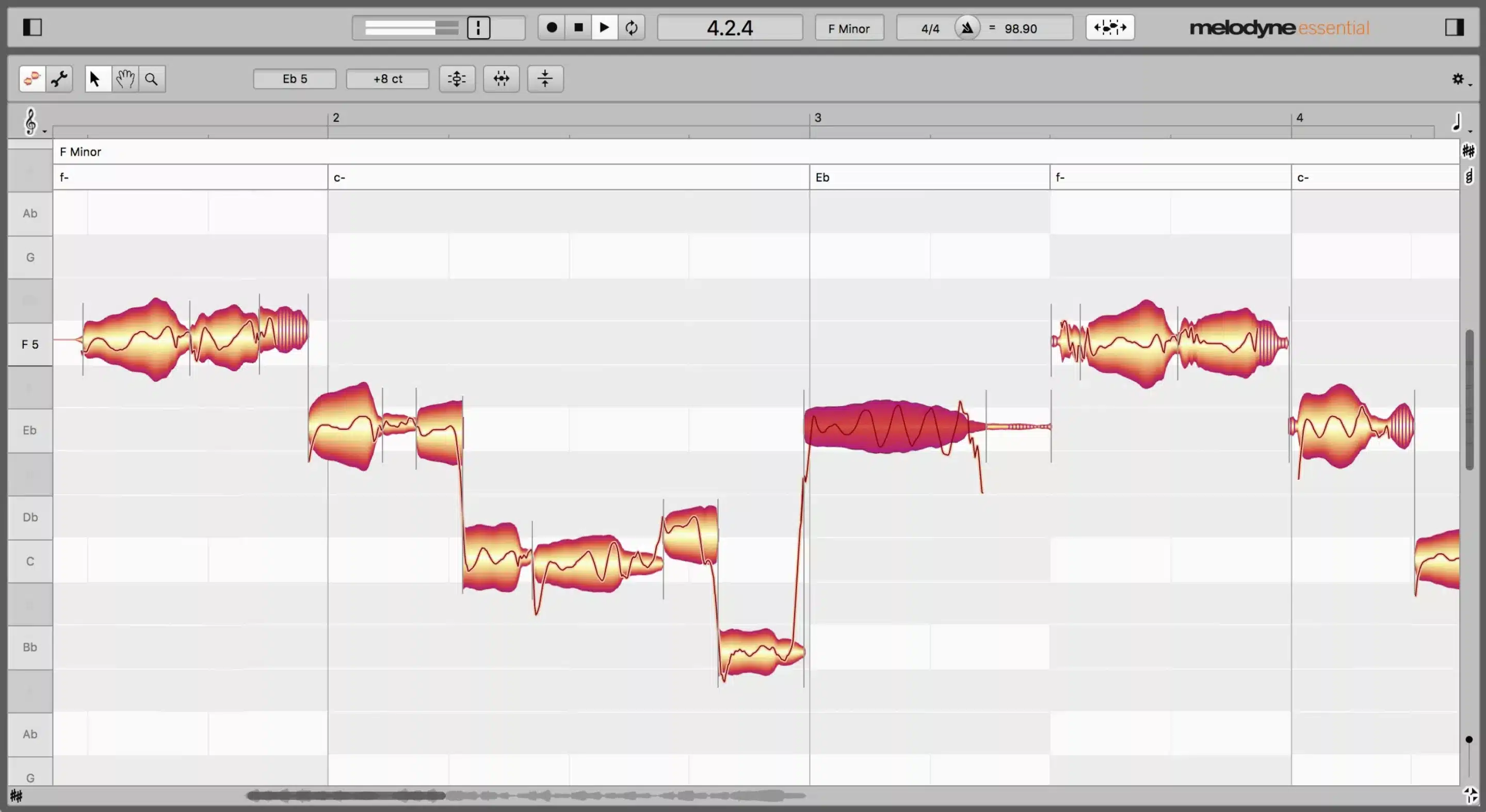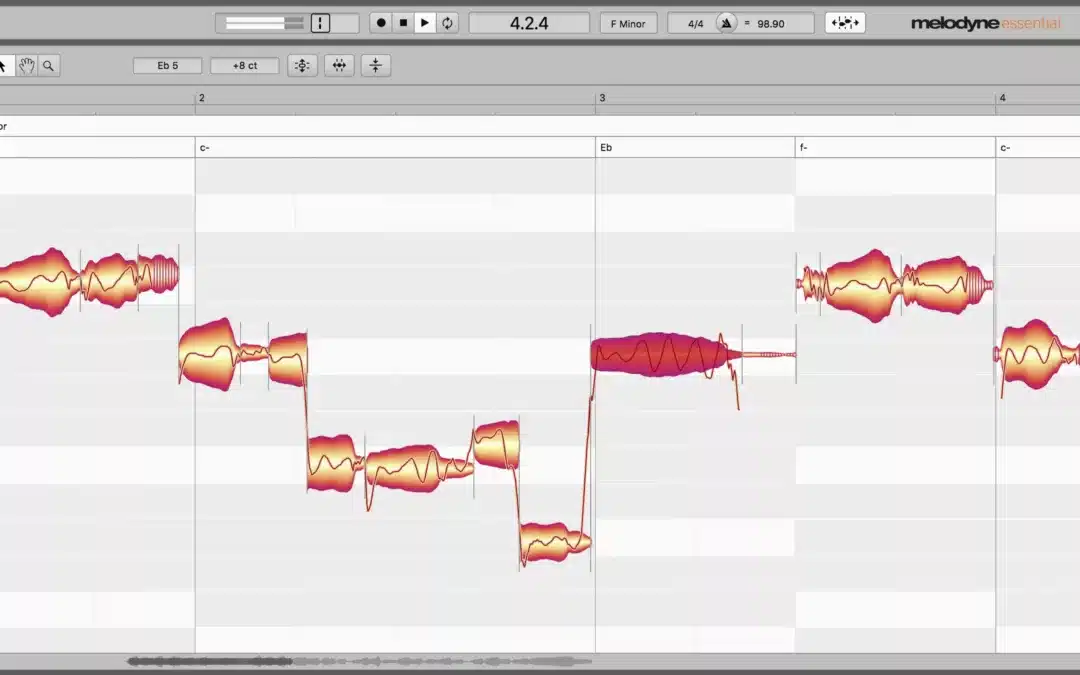Learn how to use Melodyne like a Pro.
Melodyne is an incredibly powerful piece of audio editing software that lets you manipulate audio, specifically monophonic recordings, in ways no other DAW plugin can. With Melodyne, you can finely tune vocals and instruments, correct sour notes, tweak timing and rhythms, adjust volume levels, completely alter melodies, and more. The possibilities are endless.
In this comprehensive guide for beginners to advanced users, I’ll cover everything you need to know to get the most out of Melodyne and unleash its creative audio editing capabilities.

How to use Melodyne
Importing Audio into Melodyne
The first step to using Melodyne’s powerful editing tools is properly loading your audio file into the plugin. Here are some tips:
- Record audio without any distortions, clipping, or compression artifacts. Capture dynamic range.
- Mono recordings like a vocal or a solo instrument work best. Complex polyphonic recordings are harder to detect.
- Export recorded tracks from your DAW cleanly without effects baking in.
- Save both a dry, raw audio file as well as the in-project version for flexibility.
- Try capturing a DI signal simultaneously when tracking instruments.
Step 1: Import Your Audio Track
First, open up Melodyne as a plugin in your DAW or as a standalone application. Then import the audio track you want to edit. This can be a vocal track, guitar track, etc. Melodyne works best with monophonic audio, not complex harmonies, so solo instruments or vocals work best.
When importing, ensure the audio is recorded properly without distortions or clipping. Melodyne allows you to make edits in ways no other software does, but the better the source audio, the better your results will be.
Step 2: Detect Pitch and Timing
Once your track is imported, let Melodyne analyze the audio to detect the pitches and timing. Under the Algorithm menu, select Melodic. The Melodyne algorithm will detect the notes, chords and rhythms in your audio.
You’ll see notes detected in the editable Melodyne pane. The notes are color-coded – yellow notes were uncertain or undetected. Green notes were detected with confidence. You can play back your track now and see the detected notes light up in real time.
Step 3: Edit Notes and Timing
Here’s where the magic happens! With your notes visualized, you can now manipulate and edit the audio in ways no traditional audio editor allows.
Try grabbing a note and dragging it up/down to change the pitch. Or drag it left/right to change the timing. Listen to how the audio updates to match your edits seamlessly.
You can quantize and tighten up the timing of notes easily as well. Fix out of tune vocals by dragging flat or sharp notes to the proper pitches. And so much more.
Get creative with editing rhythms and melodies. The powerful sound editing possibilities are endless with Melodyne!
Understanding Algorithms in Melodyne
Melodyne utilizes different detection algorithms that specialize in certain audio types. Choosing the right one is critical.
Melodic Algorithm – Best for clear melodic signals like vocals, woodwinds, brass, etc. Detects musical notes, pitch drift, vibrato and expression. You can then tweak notes, pitch, timing and gain very finely.
Percussive Algorithm – Made for rhythmical non-pitched audio like drums and percussion. Detects individual drum hits based on transients so you can quantize, adjust timing, and shape rhythms with incredible flexibility no traditional audio editor allows.
Polyphonic Algorithm – Analyzes chords, complex signals and even entire mixed tracks by detecting pitched elements. Allows you to manipulate chords while preserving relations between notes. Great for remastering tasks.
Universal Algorithm – A versatile hybrid algorithm that works well for mixed signals. Identifies both tonal pitched elements and transient percussive elements. The detection won’t be as specialized, but the editing flexibility bridging melodic and rhythmic editing can be very useful.
So choose the algorithm suited to your specific audio for best detection and editing results!
Editing Pitch, Timing and More
Where Melodyne really stands apart from any other plugin is how it allows you to manipulate audio after detection in ways you never thought possible. By displaying audio as editable notes and curves rather than static waveforms, radical audio alterations are right at your fingertips.
Here’s just a small sampling of powerful editing you can do:
Pitch Editing – Fix flat or sharp notes by dragging to perfect pitch center. Quantize to scales and keys. Radically alter melodies. Formant correction maintains tonal quality during shifts.
Timing Editing – Tighten up sloppy playing with unbelievable time precision and groove quantizing. Adjust pacing via tempo mapping. Change rhythmic patterns completely.
Gain Editing – Smooth out inconsistent volumes with configurable amplitude editing tools. Shape expressive dynamics.
Modulation Editing – Sculpt beautiful vibrato. Eliminate unwanted wavering. Enhance expression.
Note Separation – Isolate and edit problem sounds buried even in dense chords thanks to Melodyne’s detection capabilities.
Formant Editing – Alter formants independently of pitch so changes don’t negatively affect tonal quality, keeping natural sound.
And So Much More – Multi-track drifting tools. MIDI capability. Pitch drift handling. Algorithm sequencing. Per note effects… the list goes on!
Overview of the different versions of Melodyne:
Melodyne Essential
Melodyne Essential is the most affordable, budget-friendly option. It’s great for basic monophonic pitch and timing correction. Perfect for getting your feet wet with the software if you’ve never used it before.
Allows for pitch drift, pitch modulation, volume shaping, tuning to custom scales, quantizing, tempo changes and basic track editing.
Works best on vocals, solo instruments and simpler arrangements. Lacks some more advanced features.
Melodyne Assistant
Melodyne Assistant gives you a taste of the power the software offers. Allows for deeper, surgical editing techniques that unleash the true potential for natural-sounding but radical audio manipulation.
All of the core algorithms are available in Assistant, allowing for audio detection of monophonic and polyphonic material, plus percussive sounds. More parameters and abilities to stretch edited material even further. Formant editing ensures tonal quality remains intact when transposing.
It can edit multiple tracks simultaneously, transfer edits between tracks, and copy audio between files. Algorithm sequencing and MIDI features expand capabilities.
Great for demanding pitch, timing, and expression editing tasks on vocals, instruments, and full arrangements. It’s an affordable way to unlock Melodyne’s magic.
Melodyne Editor
Here’s where Melodyne really levels up in power. Melodyne Editor removes feature limitations so you can access every parameter and tool completely unfettered.
On top of all that Assistant offers, you gain: Tempo mapping to radically alter track pacing and rhythms. Tools to manipulate vibrato, wispy noises, and volume drifts with incredible precision. Note-specific effects. Increased algorithm accuracy for tackling more challenging material.
True creative freedom for intricate editing tasks on master-quality recordings. Overkill power for meticulous perfectionists, but allows for next-level sonic creativity in the right hands.
Melodyne Studio
The crème-de-la-crème flagship edition aimed at pro studios. Steps up the sound quality and DAW connectivity thanks to compatibility with 384 kHz, 8 channel 24/192 playback, VST3 support and ARA integration.
The studio edition is over-the-top sonic overkill aimed at elite mastering applications, film/TV post-production tasks requiring ultimate-precision editing capabilities, and next-level creative sound design. Exclusive updates add new features routinely.
In short – casual users don’t need Studio, but for the best of the best, it can’t be beat!
Whichever version fits your needs and budget, Melodyne lets you manipulate audio in ways that have to be heard and experienced to be believed. It’s a sound designer’s dream come true!
Unlocking Endless Potential
As you can see, Melodyne gives you incredible control over manipulating the pitch, timing, gain, vibrato, formants, and more of your audio. No other software allows for this level of surgical editing with sound natural results.
While it may take some time to wrap your head around editing audio as swappable notes and curves instead of static waveforms, the possibilities for shaping your sound with Melodyne literally never end.
Don’t be afraid to push the software to its limits – you can make radical melodic, rhythmic, and tonal edits while still retaining unbelievable audio quality. Let me know if you have any questions in the comments below.






